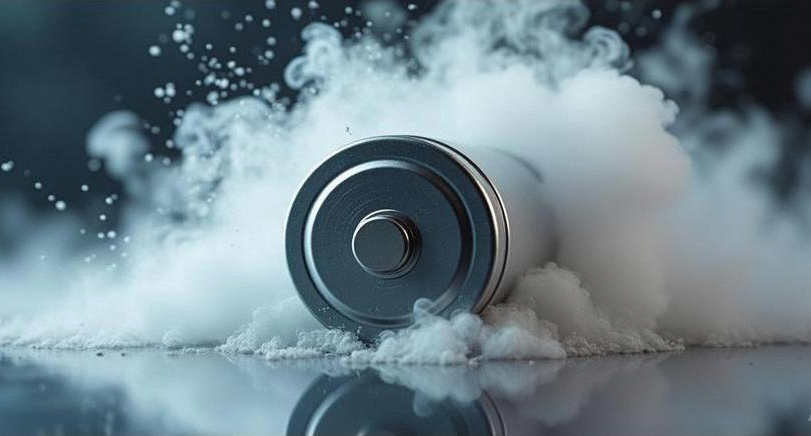
Lithium-ion batteries have high energy density, long cycle life and good charge and discharge performance. However, when a lithium-ion battery has an internal short circuit, it means that an abnormal conductive path has appeared between the positive and negative electrodes inside the battery.
Under normal circumstances, lithium ions are orderly embedded and extracted between the positive and negative electrodes through the electrolyte during the charge and discharge process, and the diaphragm can effectively prevent the direct conduction of electrons between the positive and negative electrodes. However, when an internal short circuit occurs, the insulation between the positive and negative electrodes is destroyed, and electrons can bypass the normal circuit path and flow directly from the positive electrode to the negative electrode, forming a low-resistance short circuit. This abnormal current path will lead to a series of serious consequences and is one of the important reasons for battery failure.
Common causes of short circuit in lithium-ion batteries
(1) Manufacturing defects
Metal impurities: During the manufacturing process of lithium-ion batteries, if the cleanliness of the production environment is not well controlled or the raw materials contain metal impurities, these metal impurities may be mixed into the battery. When the metal impurity particles penetrate the diaphragm and contact the positive and negative electrodes, a conductive path will be formed between the positive and negative electrodes, causing an internal short circuit.
Electrode burrs: During the manufacturing process of the electrode, if the operation is improper or the equipment is not accurate enough, tiny burrs may be generated on the edge of the electrode. These burrs may gradually penetrate the diaphragm as the battery is used, causing an internal short circuit.
(2) Damage during use
Mechanical stress: In the daily use of lithium-ion batteries, they are inevitably subject to various mechanical stresses. For example, if a mobile phone is accidentally dropped or an electric car is driven on a bumpy road, the battery may be impacted or squeezed. When the battery is subjected to large mechanical stress, the internal electrodes, diaphragms and other structures may be deformed or damaged. For example, the diaphragm may rupture, resulting in direct contact between the positive and negative electrodes, thereby causing an internal short circuit.
Temperature influence: Temperature has an important influence on the performance and safety of lithium-ion batteries. When the battery is in a high temperature environment, the chemical reaction rate inside the battery will accelerate, which may lead to problems such as electrolyte decomposition. Under extremely high temperature conditions, the performance of the diaphragm will decrease, and it may even melt, causing the isolation between the positive and negative electrodes to fail and causing an internal short circuit. On the contrary, under low temperature conditions, the internal resistance of the battery will increase and the migration rate of lithium ions will slow down, which may also cause excessive local current inside the battery and cause an internal short circuit.
(3) Battery aging
As the number of charge and discharge cycles of lithium-ion batteries increases, the battery will gradually age. During the aging process, a series of complex physical and chemical changes will occur inside the battery. For example, a thicker SEI film will gradually form on the surface of the negative electrode. The growth of this film may reduce the activity of the negative electrode material and may also produce some cracks. When these cracks expand to a certain extent, the contact between the negative electrode and the electrolyte may deteriorate, thereby causing local current concentration and leading to internal short circuits. In addition, as the number of cycles increases, the crystal structure of the positive electrode material may also change, resulting in a decrease in the stability of the material, which may also indirectly increase the risk of internal short circuits.
Impact of short circuit in lithium-ion batteries
(1) Battery capacity decay
Internal short circuits can cause self-discharge inside the battery, where a large amount of electrical energy is consumed in vain and cannot be output to the outside for use by the device. Similarly, after an internal short circuit occurs in a lithium-ion battery, its actual available capacity will gradually decrease, and the device's endurance will also be greatly reduced.
(2) Increased battery internal resistance
When an internal short circuit occurs, the current distribution inside the battery becomes uneven, and high current density appears in local areas. The increase in battery internal resistance will not only increase the energy loss of the battery during charging and discharging, reduce the battery's energy conversion efficiency, but also cause the battery to heat up during charging and discharging. If the battery is in a high internal resistance state for a long time, its life will be further shortened, accelerating the battery's failure process.
(3) Increased risk of thermal runaway
Thermal runaway is one of the most serious consequences of an internal short circuit in a lithium-ion battery. When an internal short circuit occurs, a large amount of electrical energy is converted into heat energy in a short period of time, causing the temperature inside the battery to rise sharply. As the temperature rises, the chemical reaction inside the battery will further intensify, generating more heat, forming a vicious cycle. If this heat cannot be dissipated in a timely and effective manner, when the temperature reaches a certain threshold, the battery will experience thermal runaway. In the thermal runaway state, the battery may smoke, catch fire or even explode, posing a great threat to personal safety and property safety.
Therefore, in order to prevent short circuits in lithium-ion batteries, manufacturers need to optimize the manufacturing process; users also need to strengthen management of use; regular inspection and maintenance
Bosa Energy
Bosa Energy with 150GWH capacity and over 400,000 electric bus/utility vehicle application experience we are listing first 5 in China power battery industry. We cooperate with Yutong/Geely/Damiler etc.
We are also offering Container ESS systems and delivered 6GWh in 2024(=75,000 Model3 with 80kWh battery). In local market, we are offering OEM service for Changan, CALB, National grid, Ping Gao Electric , Xuji electronics, Ruineng electronics, they are our main Container ESS suppliers in China Market.
We are the most professional supplier of marine lithium batteries in China, and our export volume of marine batteries consistently ranks among the top three in China; We are also the top 1 exporter of lithium battery modules in China, specializing in providing various lithium battery module solutions.
For excellent quality and performance our products are popular in more than 30 countries in the world. We also have established warehouse in Germany and Netherlands to provide safety stock timely delivery for our customers.
l Customized and Flexible
l High Delivery capacity
l Wide Applications
l Rich experience on Lithium battery pack







